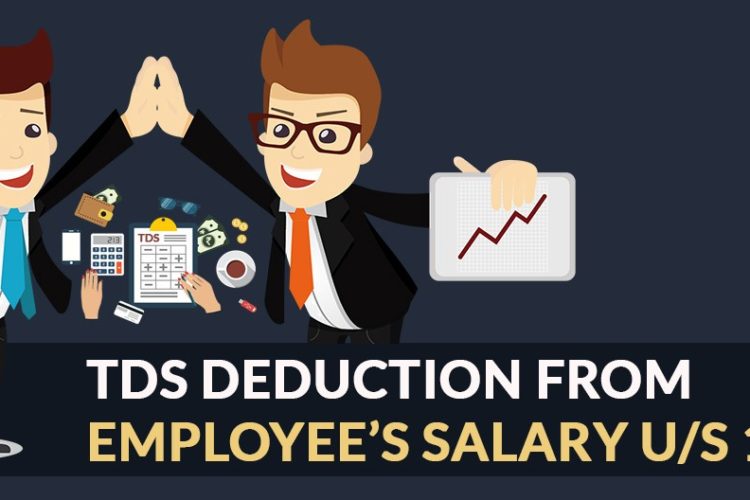As per Section 192 of Income Tax Act, “any person responsible for paying any income chargeable under the head “Salaries” shall at the time of payment deduct income tax (TDS) on the amount payable at the average rate of income tax computed on the basis of rates in force for the financial year in which the payment is made, on the estimated income of the assessee under this head for that financial year.”
What this apparently means is that deducting tax at source or TDS against the amount payable to an employee under the “salaries” head is mandatory for every employer/company in India, if the employee salary exceeds the basic exemption limit for the given financial year.
Taxes, along with additional surcharges and education cess on employee salary or payments is calculated as per the rates of the relevant financial year.
The article sheds light on some very important points that must be kept in mind by the deductors or employers while deducting TDS from employee’s salary under section 192 of the Income Tax Act. Section 192 of the Income Tax Act is applicable on all registered taxpayers in India, including individual, HUF, Firm or a company.
Documents Required for HRA, LTA and Medical Reimbursement
The employer must collect written statement from employees that disclose information about rent paid, landlord name, address of the property, etc. in order to calculate HRA exemption.
PAN details of the landlord should also be collected by the employer from the employee if the total annual rent paid by him exceeds INR 1 lakh rupees.
According to the CBDT notice, there is no need to collect rent receipt from the employees, if the HRA paid to him is INR 3000 per month or below.
In case, the employee claims for medical reimbursement, then employers can allow exemption up to INR 15,000 on submission of original medical bills or receipts.
For travel related concession, the employee should submit expenditure details or any evidence for the travel expenditure.
Previous Employer’s Salary
If the TDS from employee’s salary has been deducted at the previous employer, then it should be considered by the new employer while deducting TDS.
Therefore, TDS calculation should always be done on the basis of previous and present employer’s salary. Employees should disclose details about TDS deduction while filing returns.
TDS on Employee’s Income Other Than Salary
Employees should disclose details about all other income that is subject to tax deduction while filing their returns. If all other income sources are declared by the employee, then it also helps the employer to calculate TDS easily.
Although, the total TDS deducted by the employer post reveal of other income sources by an employee cannot be less than the amount which would have been deductible in case of non-disclosure of other income sources by the same employee.
Any loss other than loss under the “Income from house property” head should not be considered by the employer while TDS calculation.
Any employee should provide details like name, address, PAN, interest paid/payable etc. in order to claim the deduction of interest under the income from “Income from house property” head. The employee should also provide a bank statement to the employer that highlights principal and interest component separately for the same.
TDS Deduction Under 80G
Employees can claim a deduction of tax under different section like 80C, 80CCC, 80CCD, 80CCG, 80D, 80DD, 80DDB, 80E, 80EE, 80GG, 80GGA, 80TTA and a80U. Although to claim tax deduction under these sections, the employees should provide valid evidence for investment or expenditure to the employer.
For claiming tax deduction under 80G, the employee should provide evidence, i.e., receipt copy, about the money that he has donated to various government schemes like Prime Minister national relief fund, Prime Minister drought relief fund, Earthquake relief fund, etc.
The employers are not allowed to give any deduction to employees under section 80G. For claiming tax relief against the donation made to the notified public charitable institutes, the taxpayers should mention it separately while filing their tax returns.
The taxpayers should furnish the Form No 10E to the employer during TDS calculation for consideration of such relief.
TDS Deduction from Employee Salary in Case of No PAN
In case the employee does not have any Permanent Account Number (PAN), TDS from salary should be deducted at a rate of 20% without including SHEC or education cess if the normal tax rate is less than 20% by the employer. This means that TDS deducted from employee salary in case of no PAN should be either at a normal rate or 20% rate, whichever is higher.
TDS Deposit Time Limit
The tax from the employee’s salary needs to be deducted every month. After TDS deduction, the employee should furnish the same to the tax department.
If the TDS gets deducted from government office, then it should be deposited:
- On the same day where the tax is paid without producing any income-tax challan.
- On or before seven days from the end of the month in which tax is paid along with the income-tax challan.
If TDS has been deducted at any other office apart from the office of the government, i.e., all other cases) then it must be furnished:
- On or before 30th April, for the income or amount credited or paid in March.
- On or before seven days from the end of the month in which tax has been deducted.
TDS statement Submission to the Tax Department
After TDS deduction, the employer should submit the TDS statement on a quarterly basis to the income tax department in an electronic format along with Form 27A for verification of the statement.
Here are the dates and Forms that should be submitted to the tax department by the employer:
| TDS statement period | Last Date of FIling | TDS statement Form |
| April to June | 31st July to the given fiscal year | 24Q |
| July to September | 31st October | 24Q |
| October to December | 31st January | 24Q |
| January to March | 31st May | 24Q |
The employees can check the amount of TDS deducted from their salary with the help of Form 26AS, after filing of these TDS statements.
After filing these TDS statements, the employee can check the amount of tax deducted from his salary in form 26AS.
TDS-related Documents Provided by Employer to Employee
The employer should furnish a statement with complete and accurate details about the profits against the salary provided to its employees in Form No. 12BA on or before 31st May of the given assessment year or the following financial year, as per the section 192(2C) and rule 26A (2).
Employer can at the time of making any deduction, increase or reduce the amount to be deducted under section 192 for the purpose of adjusting any excess or deficiency arising out of any previous deduction or failure to deduct during the financial year. Gen TDS Software from SAGInfotech is one of the best software available in the tax industry. With this an organisation or business can easily perform the task of TDS deduction from the earnings of working employees without any hassle. Also, the e-filing of TDS via Gen TDS Software follows a few clicks for TDS deposition to the government. So, opt for Gen TDS Software and run your business seamlessly.


